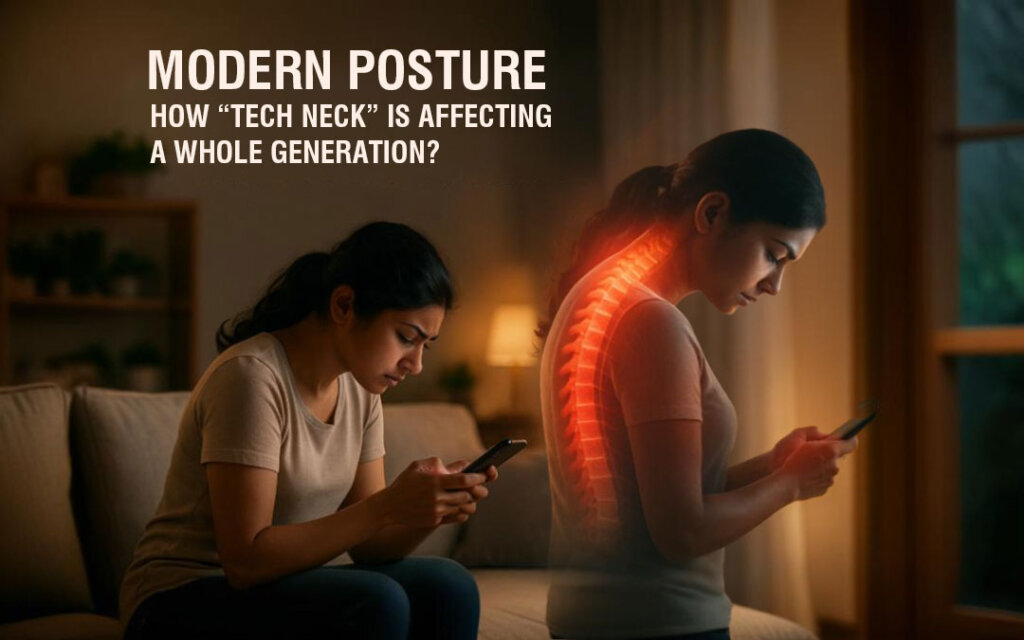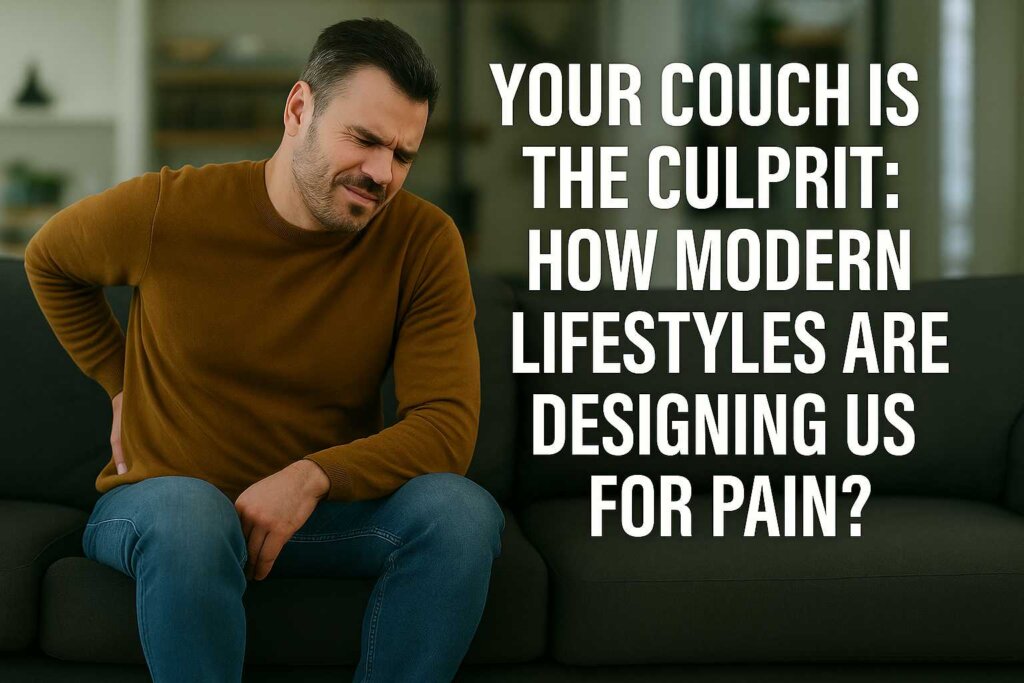
Call Us Now :
-
Call Us Now: 9807 55 6789Call Us Now: 9807 55 6789
Home » YOUR COUCH IS THE CULPRIT: HOW MODERN LIFESTYLES ARE DESIGNING US FOR PAIN?

Imagine this scenario.
You get up from your bed. Then shuffle over to the kitchen to grab your coffee. Later, you collapse onto the couch.
OR
Your daily routine could involve sitting for hours at an office desk. Only to later return home and sink into your couch’s soft embrace.
Your couch is comfortable. But at the same time, could be the reason you’re waking up with a sore back. Else you could be waking up to feel that nagging pain in your hips or neck.
The reality is modern lifestyle that’s dominated by comfort and convenience, is quietly reshaping human bodies for the worse. It is setting us up for chronic pain. We may not be hauling heavy loads or even plowing fields. But, we’re just facing a new level of physical threat – inactivity.
Surprisingly in this regard, one of the biggest culprits is your couch – symbol of relaxation.
Human body was not designed for long periods of sitting.
Instead, human evolution crafted us to move, walk, run, climb, squat, and hunt.
Modern living however has turned humans into expert sitters. Today, most humans sit at work, or in the car, or at the dinner table. Else just sit more time while unwinding at the end of the day.
The whole problem is not just sitting. It is the chronic aspect of it. This is especially more so when it’s combined with poor sitting posture and unsupportive furniture.
CDC and WHO studies reveal an average adult today spends no less than 10 hours in a day sitting. This could be even more for remote workers or binge-watchers. Much of that time is spent on couches. That is too soft or too deep, and ergonomically disastrous.
A great majority of couches are made to feel plush.
Low seats with deep backs and oversized cushions can feel cozy. But they provide for the spine, hips, or neck, little support. Your pelvis often tilts when you slump into that ultra-soft sofa, backward. They flatten the natural curve of your lower back, that is, the lumbar spine.
This positioning over time leads to postural distortions. They result in weakened core muscles and chronic discomfort.
The following tells how your couch could be contributing to pain.
Our homes and gadgets are getting smarter. However, our bodies are becoming more dysfunctional.
This has brought to focus growing mismatch between the two. That is, the way human bodies were designed to move and the way humans live. The chasm between the two is growing.
Ergonomics which means the science of optimizing design for human use comes into focus here. It is often ignored in home furniture. This is especially all the more so when style takes precedence.
Now, let us consider the following scenario. Office chairs today mostly come with lumbar support supplemented with adjustable armrests and height mechanisms. That’s because it’s recognized the damage bad posture can cause over time. However, living room furniture still is struck in the old fashioned mode. They’re meant more for visual appeal rather than for long-term use.

Pain very rarely gets isolated.
A tight hip can cause lower back pain. Similarly, a weak core can result in the shoulders to overcompensate. These imbalances can over time develop into chronic conditions. Like for instance, herniated disc, or carpal syndrome or sciatica. Even simple tasks when the body is out of alignment, can become a problem. Like standing or walking.
Let us say you’re caught in the following scenario,
All of the above start slowly and innocently. They gradually increase the pain with time spent on the couch.
Human mind and body are interwined deeply.
Chronic pain does not just have a bearing on physical health. It also has an effect on mental well-being.
Persistent discomfort can result in reduced focus. They can also cause sleep disturbances and even depression or anxiety. Human brain struggles when the body is constantly signals that something is wrong, to stay calm and focused.
Worse still, much of the pain develops gradually. This thrives when we humans constantly remind selves that the pain is just getting older or occurred after a bad night’s sleep. But in reality, reality is we humans are accommodating poor movement patterns that are created by our environment.
SO, WHAT TO DO ABOUT IT?
First, the good news is you do not have to throw out your couch to start living on a yoga mat. Instead, try small, intentional changes. They can have a big impact.
Like,
REDESIGN YOUR ENVIRONMENT:
It’s critical as smarter homes and more efficient lifestyles are built, not to leave our bodies behind.
Modern living comfort should not come at the cost of our health.
We can design with awareness and small alterations, a lifestyle that honors how our bodies are meant to live and move.
Just imagine you have a home that supports your health. Just as much it facilitates and supports relaxation. It is a place that encourages movement, not discourages it. Now imagine using your couch in a manner that promotes recovery and not deterioration.
Your body speaks a story of how you live.
Every stiff muscle, every ache, or every twinge of pain sends a signal. Note the warning signs and consider your surroundings and habits instead of ignoring it or blaming it on growing age.
Your couch is shaping your posture and your movement patterns. It is also shaping your health in subtle, but damaging ways. This sends a message to reassess how you use the couch. Know that body comfort should support body movement and not replace it.
The next time you ease into the couch. Take a moment to reflect and check your body posture. To support proper body posture, you could stretch during the commercial break. Else go for a walk before dinner.
Proper awareness remains your first defense in the battle against chronic pain. In this, your couch does not have to be the culprit always or anymore.
Join our mailing list to get updates about our services and procedures or any events and discounts.

Indo-British Advanced Pain Clinic © 2025. All Rights Reserved. Designed & Developed By Adroit
WhatsApp us